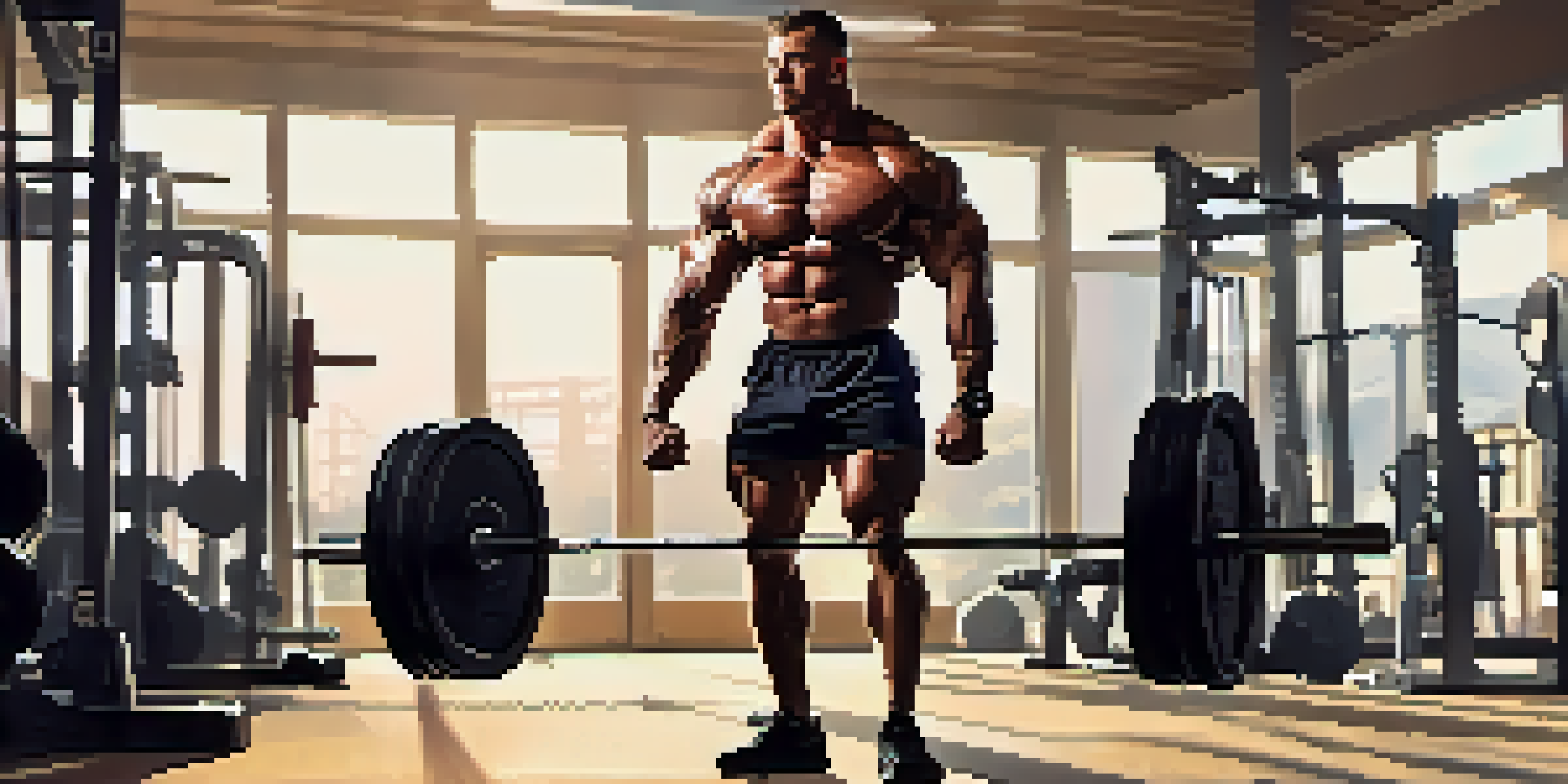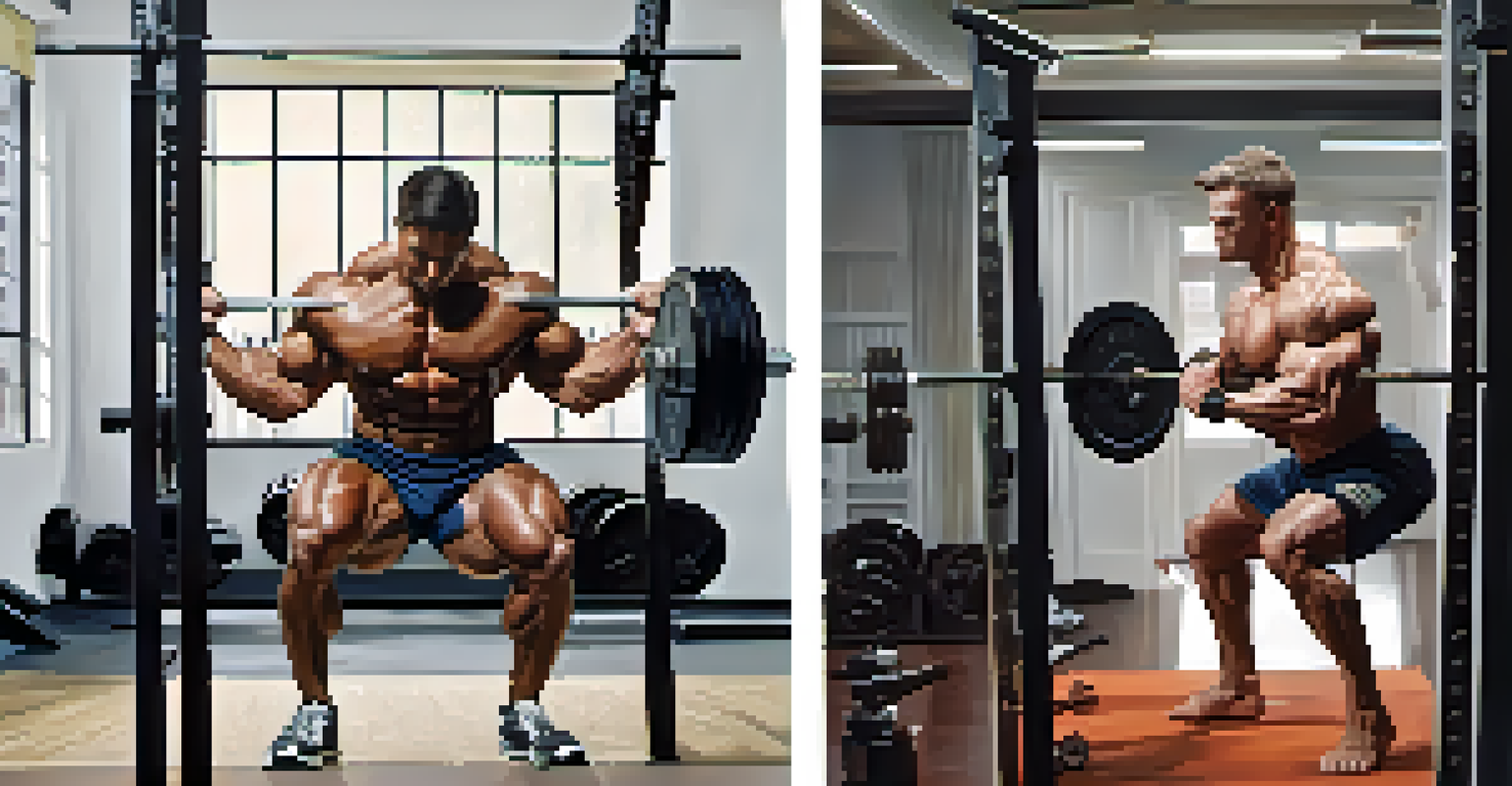Training Regimens: Strength vs Aesthetic Bodybuilding

Understanding Strength Bodybuilding Training
Strength bodybuilding focuses primarily on increasing the maximum weight you can lift. This type of training often involves compound movements like squats, deadlifts, and bench presses, which engage multiple muscle groups. The goal is to build functional strength that can be applied in real-world scenarios, making it more than just about looks.
Strength does not come from physical capacity. It comes from an indomitable will.
Training regimens for strength usually incorporate lower repetitions and heavier weights. For example, a typical strength workout might consist of performing 3-5 sets of 3-8 repetitions at 85% or more of your one-rep max. This approach places greater stress on the muscles, leading to adaptations that promote strength gains over time.
Moreover, strength training often requires longer rest periods between sets—sometimes up to 3-5 minutes. This allows your muscles to recover adequately before tackling the next heavy lift, ensuring optimal performance. It's about pushing limits and seeing how strong you can really become.
The Focus of Aesthetic Bodybuilding Training
In contrast, aesthetic bodybuilding is all about the visual appeal of muscles. This training method emphasizes symmetry, proportion, and overall muscle definition rather than just raw strength. Think of it as sculpting a statue—every detail matters, from the shape of the shoulders to the definition of the abs.

Aesthetic training typically uses higher repetitions with moderate weights, usually around 8-15 reps per set. This range helps to promote muscle hypertrophy, which is the increase in muscle size due to the enlargement of its fibers. By focusing on volume, aesthetic bodybuilding creates that coveted 'pump' look, making muscles appear fuller and more defined.
Strength vs. Aesthetic Goals Defined
Strength training focuses on lifting heavier weights, while aesthetic bodybuilding emphasizes muscle size and definition.
Rest periods in aesthetic training are generally shorter, often around 30-90 seconds between sets. This keeps the heart rate up and maximizes muscle fatigue, contributing to that visual appeal. The emphasis here is not just on getting stronger but also on looking good while doing it.
Key Differences: Goals and Approaches
The primary distinction between strength and aesthetic bodybuilding lies in their goals. Strength training is about lifting heavier weights, while aesthetic training emphasizes muscle size and shape. Understanding this fundamental difference can help you choose a training style that aligns with your personal fitness goals.
The only way to prove you are a good sport is to lose.
Another notable difference is the type of exercises commonly used in each regimen. Strength training relies heavily on compound lifts, whereas aesthetic training often includes isolation exercises. For example, bicep curls are a staple in aesthetic training, focusing solely on the bicep muscle, while strength training might use barbell rows for overall upper body strength.
It's also important to consider how these approaches affect nutrition. Strength athletes often prioritize protein intake to support muscle recovery and growth, while aesthetic bodybuilders might focus on overall caloric intake to maintain a lean physique. Both require careful planning, but the specifics can vary significantly.
Common Misconceptions About Each Regimen
One common misconception is that strength training will lead to a bulky physique that lacks definition. In reality, many strength athletes maintain a lean appearance while maximizing their strength. It's all about how you structure your training and nutrition to meet your specific goals.
Conversely, some believe that aesthetic bodybuilding doesn't build functional strength. However, many aesthetic athletes can lift significant weights and perform well in various physical activities. The key is that they prioritize muscle symmetry and aesthetics while still developing a solid strength base.
Training Approaches Differ Significantly
Strength training utilizes lower reps and longer rest periods, whereas aesthetic training involves higher reps and shorter rest times.
Another myth is that you can’t combine the two regimens. In fact, many successful athletes incorporate elements of both strength and aesthetic bodybuilding into their routines. This balanced approach can lead to a well-rounded physique that's both strong and visually appealing.
How to Choose the Right Regimen for You
Choosing between strength and aesthetic bodybuilding often comes down to personal goals and preferences. If your main objective is to lift heavier weights and improve functional fitness, strength training might be the way to go. On the other hand, if you're drawn to the idea of sculpting your physique and achieving that 'beach body,' aesthetic bodybuilding could be a better fit.
Consider also your lifestyle and schedule. Strength training might require longer sessions and more recovery time, while aesthetic training can be more flexible with shorter workouts. Assessing your available time for training can help guide your decision.
Lastly, think about what excites you! If you find joy in the process of pushing your limits and seeing how strong you can get, strength training could be your passion. Conversely, if you love the idea of transforming your physique and seeing visible changes, aesthetic bodybuilding may motivate you more.
Incorporating Both Approaches into a Balanced Routine
For those who want to enjoy the benefits of both strength and aesthetic training, a balanced routine can be highly effective. You might consider a split training regimen where certain days focus on strength and others on aesthetic work. For instance, you could dedicate two days to heavy lifting and two days to high-rep exercises.
Another approach is to incorporate both styles within a single workout. Start with heavy compound lifts to build strength, then follow up with isolation exercises to enhance muscle definition. This way, you can gain strength while also improving your visual appeal.
Combining Both Regimens is Beneficial
Incorporating elements of both strength and aesthetic training can lead to a well-rounded physique that is both strong and visually appealing.
Remember, the key is to listen to your body and adjust your training according to how you feel. Mixing both regimens can lead to a well-rounded approach that not only meets your strength goals but also enhances your physique.
Conclusion: Finding Your Unique Path in Bodybuilding
In conclusion, understanding the differences between strength and aesthetic bodybuilding is essential for any fitness enthusiast. Each approach has its unique benefits, and the choice ultimately depends on your personal goals and preferences. There’s no one-size-fits-all answer; it’s about what resonates with you.
Whether you gravitate towards the raw power of strength training or the sculpted look of aesthetic bodybuilding, the most important thing is to enjoy the journey. Find a regimen that motivates you and keeps you engaged, as consistency is key in any fitness endeavor.

As you embark on your bodybuilding journey, remember that it’s perfectly okay to evolve your training style over time. You might find that what works for you now could change as your goals and interests develop. Embrace the process and celebrate each step along the way!